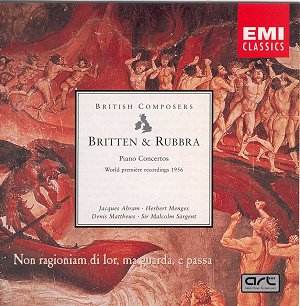 Composer: Constant Lambert
Composer: Constant Lambert
Works: Horoscope (1937), Apparitions (1936), Dante Sonata (1949), The Rio Grande (1927)
Performers: Liverpool Philharmonic, Philharmonia, Sadlers’ Wells Orchestra, Louis Kentner (piano), Kyla Greenbaum (piano), Gladys Ripley (conductor), Philharmonia Chorus
Recording: Various dates, 15 May 1945 (Horoscope), 14 Jan 1949 (Apparitions, Rio Grande), 20 March 1940 (Dante Sonata)
Label: Pearl GEM 0069
Constant Lambert occupies a unique niche in the pantheon of British composers, a position bolstered by his fervent engagement with the ballet, a medium that captivated him both personally and artistically. The release of “Lambert Vol. II” by Pearl Records showcases a selection of Lambert’s ballet music, encapsulating his aesthetic sensibilities and his intricate relationship with dance, particularly through the lens of his infatuation with Dame Margot Fonteyn. This compilation thoughtfully presents Lambert’s orchestrations of ballet works, along with his interpretations of Liszt, revealing a composer who deftly blended the romantic with the modernist, and who, despite the vicissitudes of his career, left an indelible mark on 20th-century music.
The disc opens with “Horoscope,” a suite from the ballet that reflects Lambert’s ability to encapsulate astrological themes through musical language. The five tracks presented here are a testament to Lambert’s orchestral color and rhythmic vitality. The “Dance for the followers of Leo” crackles with energy, characterized by its vigorous rhythmic patterns, while the “Sarabande for the followers of Virgo” exhibits a Ravel-like lucidity and restraint, providing a moment of introspective calm. The “Bacchanale” is a frenetic whirlwind, evoking the celebratory spirit inherent in its subject matter. These movements, while distinct in character, coalesce into a cohesive narrative that mirrors the symbolism of the astrological themes, drawing parallels to contemporaneous works by Arthur Bliss, thus situating Lambert firmly within the British musical landscape of the time.
Contrastingly, “Apparitions” and the “Dante Sonata” reflect Lambert’s proclivity for Liszt’s Romantic legacy, reimagined through his modern sensibilities. “Apparitions,” with its synthesis of influences from Massenet and Shostakovich, emerges as an affectionate yet sardonic homage to Liszt’s thematic repertoire. The orchestration by Gordon Jacob lends a textural depth that is both engaging and occasionally overwhelming, particularly in sections requiring nuanced brass flourishes. Louis Kentner’s interpretation of the “Dante Sonata” as a ‘Concertstück’ rather than a conventional concerto frames the work’s emotional arc with a visceral intensity. However, the sonic fidelity of the recording, particularly in the brass sections, occasionally detracts from the overall experience, leaving a desire for a more polished auditory representation.
The final work, “The Rio Grande,” stands out as an embodiment of Lambert’s stylistic exuberance. Kyla Greenbaum’s performance is imbued with a spirited energy that recalls the virtuosic flair of Martha Argerich. The orchestration here showcases Lambert’s gift for melody and rhythm, crafting a tapestry that both captivates and resonates. Although Gladys Ripley’s vocal contributions may strike contemporary listeners as somewhat dated, they fit naturally within the context of the piece, adding an essential layer to its narrative depth.
Pearl’s release not only serves as a valuable addition to the Lambert discography but also highlights the composer’s multifaceted genius, bridging the realms of ballet and concert music. The historical context of these works, alongside Lambert’s unique interpretation of Liszt, invites listeners into a rich world where music and dance intertwine with profound emotional resonance. This collection stands as a testament to Lambert’s artistic legacy, one that continues to inspire curiosity and admiration. The meticulous care taken in curating this volume affirms Pearl’s commitment to preserving important musical heritage, ensuring that Lambert’s contributions remain accessible for future generations.



